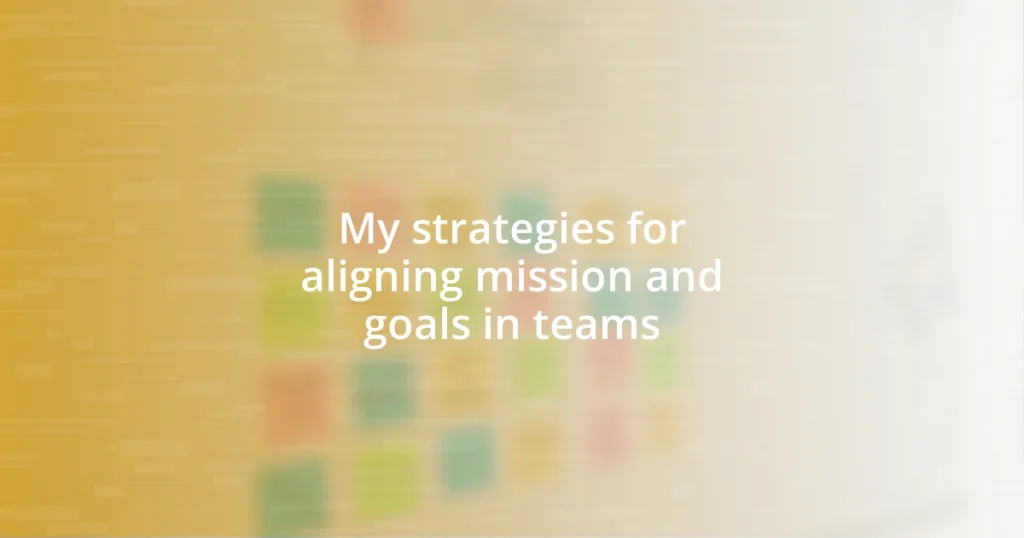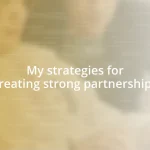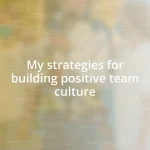Key takeaways:
- Alignment around a common mission enhances teamwork, communication, and individual motivation, fostering a sense of belonging and commitment.
- Engaging team members in goal-setting and discussions builds ownership, clarity, and trust, leading to a more collaborative environment.
- Regular celebration of achievements, both big and small, strengthens team bonds and maintains motivation throughout the project’s journey.
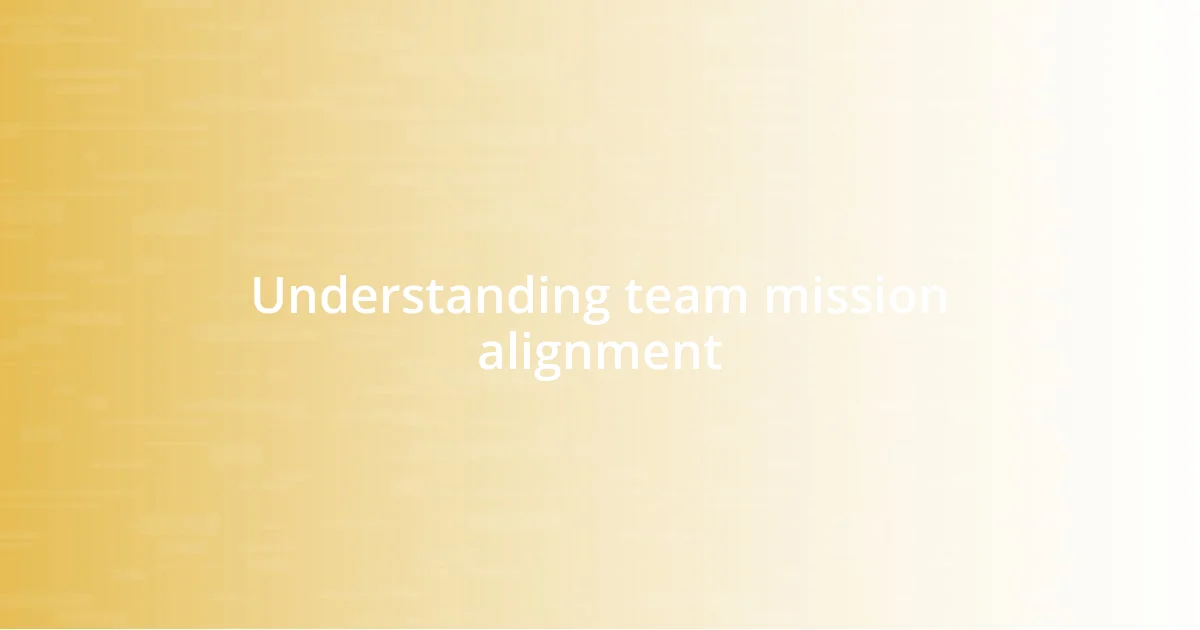
Understanding team mission alignment
Understanding team mission alignment is crucial for cohesive teamwork. I remember a time when I joined a new project team and felt the disconnect between our individual motivations and the overarching objectives. It struck me then that when a team truly understands and embraces its mission, it creates a unified force that can tackle challenges more effectively.
Have you ever noticed how teams that lack clear alignment often struggle with communication? I’ve seen firsthand how the absence of a shared mission can lead to frustration and wasted effort. The emotional toll on team members can be significant as they grapple with confusion about their roles and the purpose of their work. Reflecting on this, it’s evident that a well-defined mission acts as a guiding star, helping team members navigate their tasks with a sense of purpose and clarity.
Ultimately, alignment around a common mission isn’t just about the end goals; it’s about fostering a sense of belonging and shared commitment. During a particularly challenging project, we revisited our mission together, and it sparked a renewed enthusiasm among us. This experience taught me that when everyone is on the same page, the team transforms into a motivating environment where members feel valued and invested in their collective success.
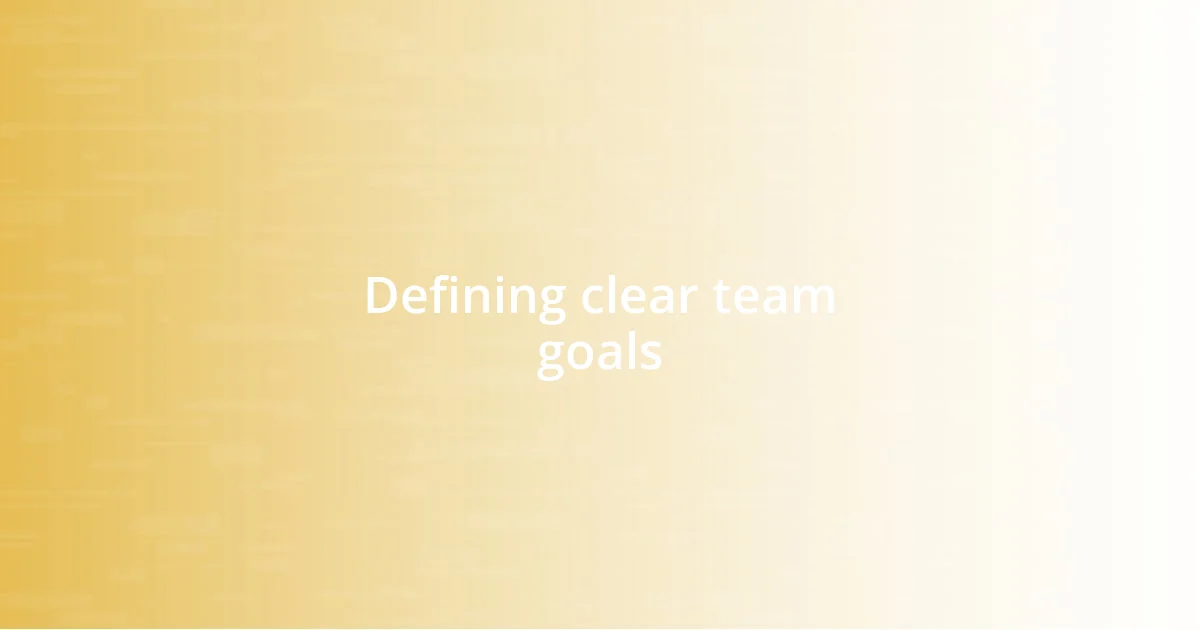
Defining clear team goals
Defining clear team goals is essential for creating a sense of direction and focus. I recall a project where we struggled initially because our goals felt vague and unstructured. It wasn’t until we brought everyone together to clarify what we wanted to achieve that I felt the atmosphere shift; suddenly, everyone was aligned and motivated. It was like turning on a light in a dark room.
To effectively define team goals, consider the following steps:
- Involve all team members in the goal-setting process to foster ownership and commitment.
- Make goals specific and measurable, so everyone knows exactly what success looks like.
- Set realistic timelines to create urgency without overwhelming the team.
- Ensure alignment with the overall mission and values of the organization, reinforcing why these goals matter.
- Review and iterate on the goals regularly, adapting them as needed based on team feedback and changing circumstances.
When we implemented these steps, it not only clarified our path but also built trust within the team. I’ll never forget the feeling when we collectively celebrated the achievement of our goals, reinforcing our bond and commitment to each other and our mission.
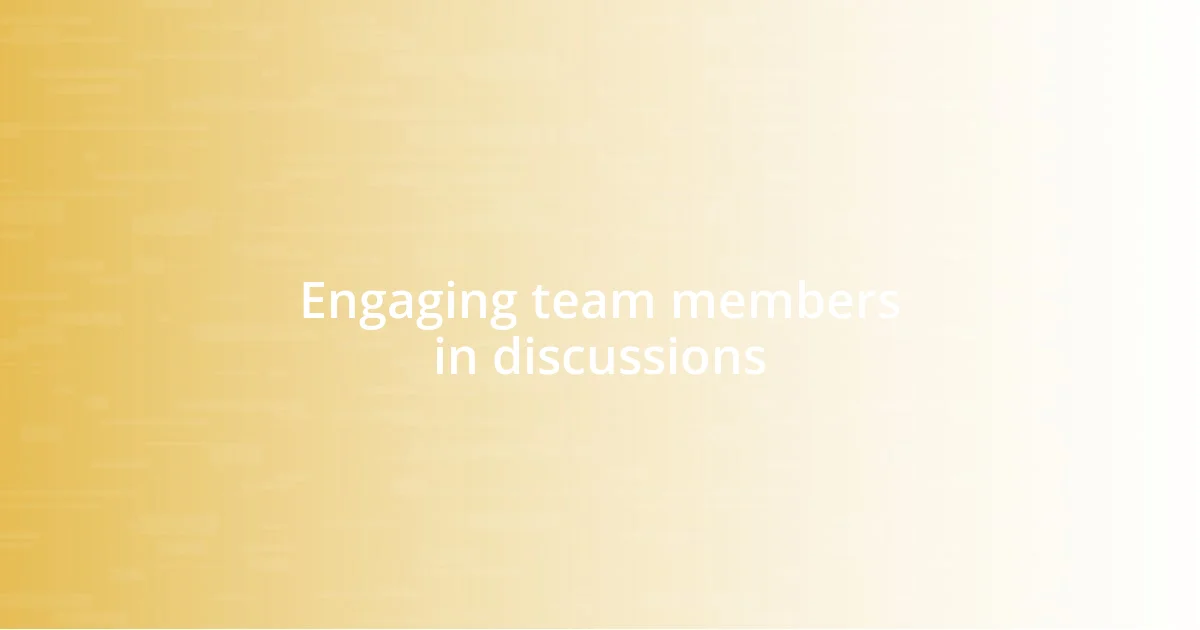
Engaging team members in discussions
Engaging team members in discussions is crucial for fostering a collaborative environment. I’ve found that the most effective way to spark conversation is by inviting team members to share their experiences and perspectives. It’s fascinating to see how introducing a simple question can open up a floodgate of ideas. I remember a brainstorming session where I asked, “What obstacles have you faced in achieving our mission?” The room lit up with diverse insights, revealing not only challenges but also solutions that we hadn’t considered before.
Active listening plays a vital role in these discussions. I’ve noticed that when team members feel heard, they become more willing to contribute openly. During one meeting, I made a deliberate effort to acknowledge everyone’s input by summarizing their thoughts and thanking them for sharing. This not only created a respectful atmosphere but also encouraged quieter members to speak up. It’s like working with a tight-knit community where every voice matters—the more people participate, the richer the dialogue becomes.
Creating a safe space for vulnerability can greatly enhance discussions as well. I remember sharing a personal struggle related to our project, which surprisingly led others to open up about their own challenges. This connection transformed our team dynamics, fostering trust and camaraderie. When team members feel safe to express their thoughts and emotions, it paves the way for deeper discussions that align their individual motivations with the team’s mission.
| Engagement Technique | Description |
|---|---|
| Open-Ended Questions | Encourages broader discussions by soliciting diverse opinions and experiences. |
| Active Listening | Involves genuinely hearing and responding to team members’ input, fostering a respectful dialogue. |
| Creating Safe Spaces | Allows for vulnerability and personal sharing, enhancing trust and connection within the team. |
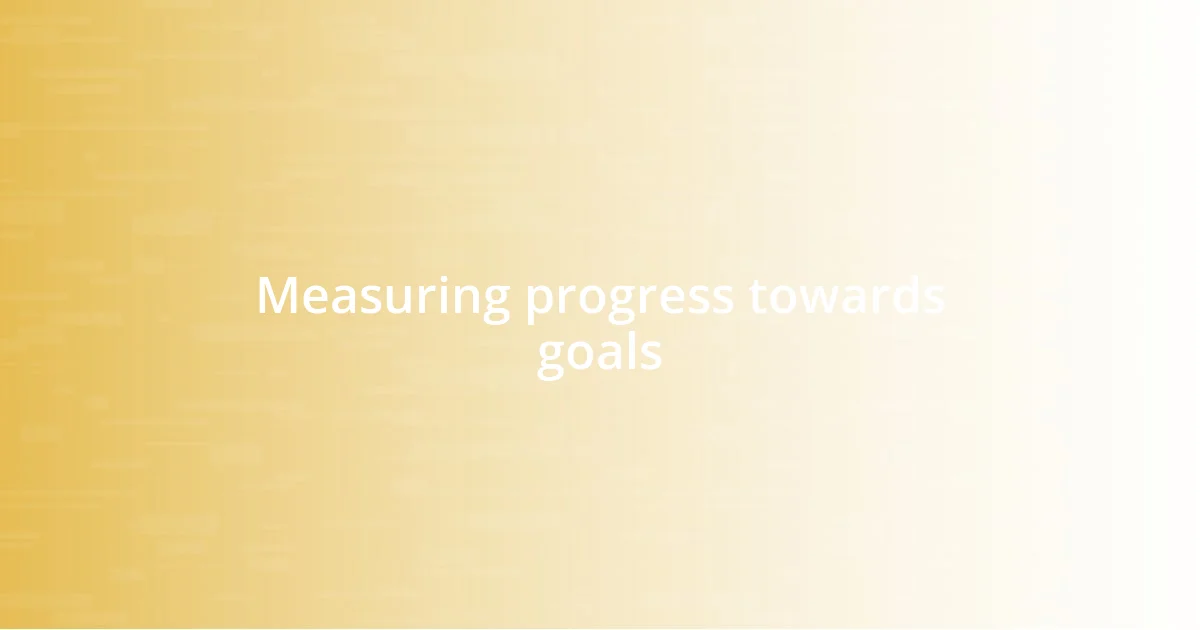
Measuring progress towards goals
Measuring progress towards goals is a pivotal aspect of maintaining team momentum. In one project I managed, we established a regular check-in, where everyone shared their progress. Having that routine not only kept us accountable but also created an environment where we celebrated small wins along the way. It’s rewarding to witness the gradual accumulation of success, isn’t it?
Another effective method I’ve employed is using visual tools like progress charts or dashboards. There’s something motivating about seeing our collective achievements mapped out in real-time. I recall vividly when our team used a shared digital board; it became a source of excitement, as we could move tasks into the ‘completed’ section together. It transforms the often daunting journey of achieving large goals into a more tangible and engaging experience. How do you visualize your team’s progress?
Finally, regular feedback sessions can be instrumental in measuring our goals. I remember one instance where a simple open forum revealed that several team members felt certain milestones weren’t clearly defined, which affected their motivation. By encouraging this feedback, we adapted our approach and made the necessary adjustments. Isn’t it incredible how listening to each other can refine our path to success?
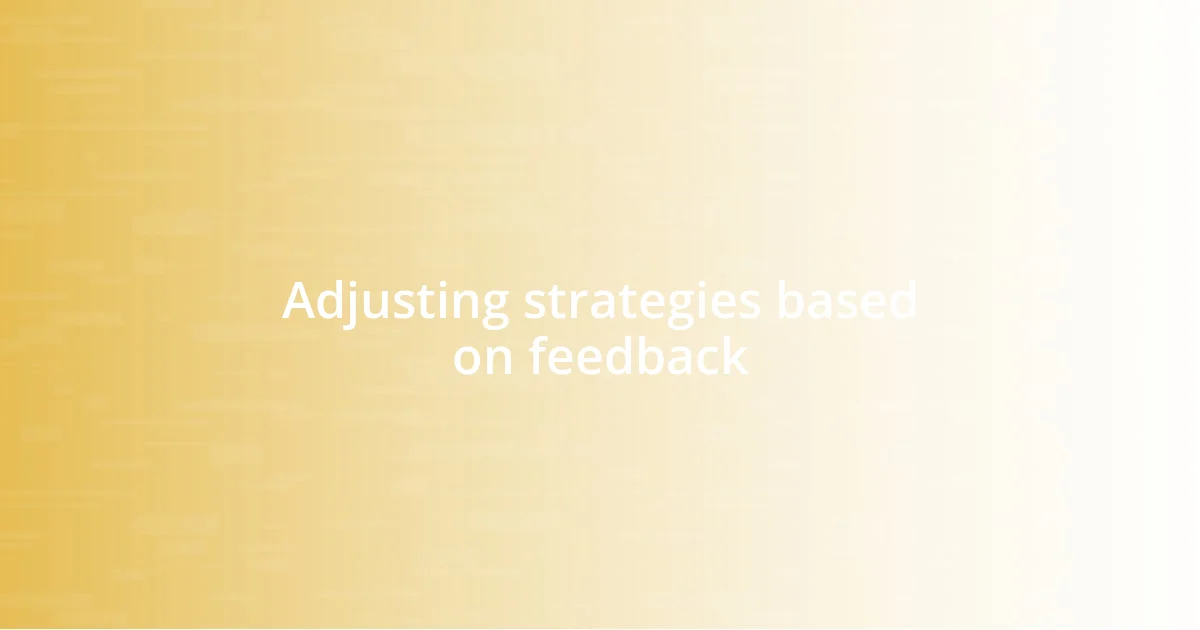
Adjusting strategies based on feedback
To effectively adjust strategies based on feedback, it’s crucial to create a feedback loop that feels natural and ongoing. I learned this when my team implemented anonymous surveys after major project milestones. Initially, I hesitated, worried about potential negativity. However, the insights we received were eye-opening, helping us strengthen areas we hadn’t realized were weaknesses. It’s fascinating to see how a little vulnerability in gathering feedback can lead to significant improvements.
I’ll never forget a time when our quarterly reviews revealed mixed feelings about our objectives. Many team members expressed that our goals felt disconnected from their day-to-day tasks. Instead of brushing these concerns aside, we held a workshop to re-align our goals more closely with their experiences. The energy shift after that was palpable—aligning our mission with their feedback reignited their passion. Isn’t it amazing how simple adjustments in strategy can lead to newfound motivation?
Incorporating real-time feedback can be incredibly dynamic as well. I recall introducing a quick daily stand-up format where team members shared one success and one challenge. This not only kept everyone updated but allowed us to tweak our strategies almost instantly. After a few days, I noticed a rise in enthusiasm; we felt like a well-oiled machine, constantly adapting to the road ahead. Have you ever experienced that kind of momentum in your own teams? It’s exhilarating to see how feedback truly shapes progress.
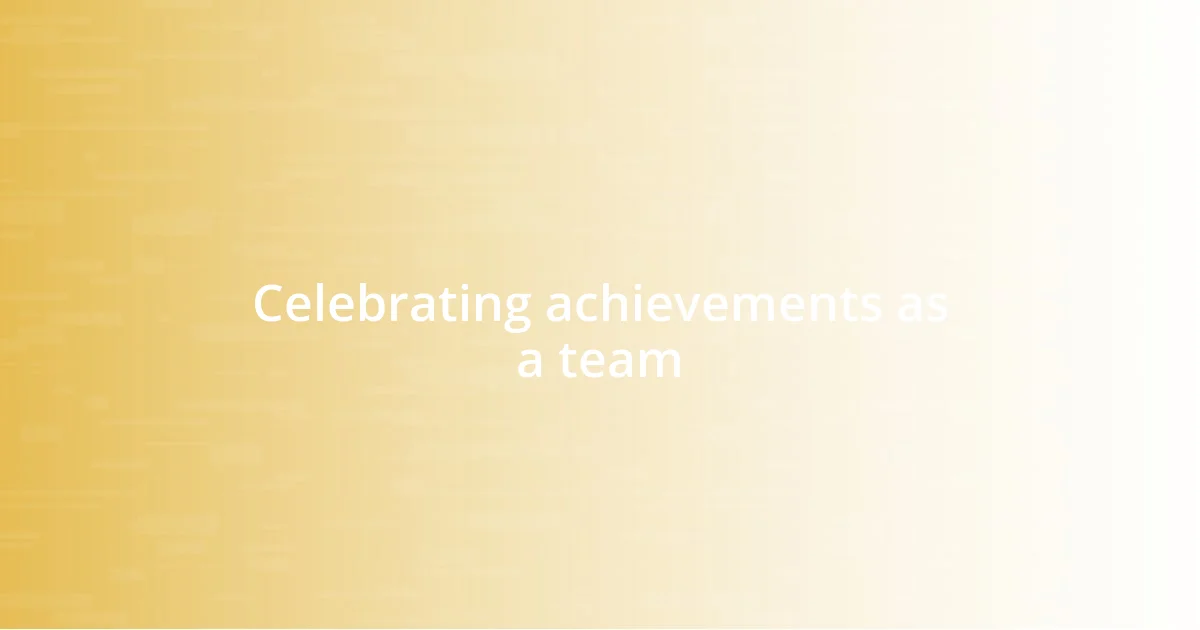
Celebrating achievements as a team
Celebrating achievements as a team not only strengthens bonds but also fuels motivation. I remember a project wrap-up where we organized a small party to honor everyone’s contributions. The laughter, shared stories, and recognition of each person’s hard work transformed that day into a memorable milestone, reinforcing a sense of belonging. Have you ever experienced a moment when appreciation made all the difference in your motivation?
It’s essential to acknowledge progress along the way, not just at the end. During one lengthy project, we set aside time every few weeks to celebrate even the smallest victories—like completing a challenging task or hitting a benchmark. This practice created a rhythm of positivity that boosted our morale and reminded us that every step forward was worthwhile. What kinds of celebrations do you think resonate most with teams?
I’ve found that recognizing achievements helps maintain focus on our shared goals. One time, I surprised the team with personalized thank-you notes highlighting specific contributions. The reactions were priceless; it fostered a culture of appreciation that went beyond standard recognition. It made me realize that when we genuinely celebrate our successes together, we create a powerful incentive to keep striving for excellence. Don’t you think celebrating achievements is vital for team spirit?










